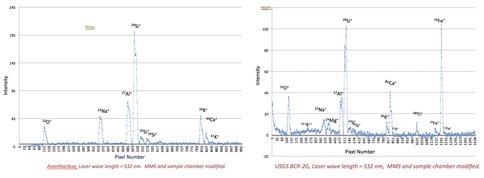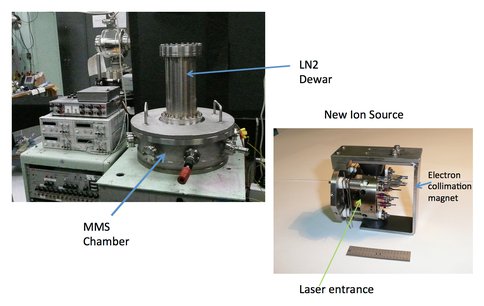2012 Annual Science Report
 University of Wisconsin
Reporting | SEP 2011 – AUG 2012
University of Wisconsin
Reporting | SEP 2011 – AUG 2012
Project 5B: A Rover-Based Miniature Mass-Spectrometer - Breakthroughs in Laser Ablation Analysis and Geochronology
Project Summary
We have made great progress towards a technique to measure absolute ages of rocks using laser sampling methods and mass spectrometry. A laser is used to release potassium and argon from rocks containing feldspar minerals, and after measuring the amount of potassium and argon released we can calculate how old the rock is. Last year, we demonstrated that the potassium and argon are released from the rock using lasers. This year, we modified our instrument so that both the potassium and argon measurements can be made during the same experiment.
Project Progress
We demonstrated that using a frequency doubled laser at 532 nm instead of the fundamental at 1064 nm is a more efficient way of doing laser ablation. Spectra of anorthoclase and USGS BCR 2G are shown in Figure 1. After proving that the green laser is appropriate, we set out to make some necessary modifications to the system in order to be able to make the argon measurement.
In the past year we have completed three key modifications of the apparatus which are required because of specific requirements of the measurement. To properly measure argon released from the rock by laser ablation, we need to measure in static mode. Static mode is when the vacuum system is blocked off from the chamber pumping system. We installed a gate valve in between the vacuum pump and analysis chamber to allow for blocking the main turbomolecular pump off from the mass spectrometer chamber.
To be able to maintain sufficient vacuum for doing mass spectrometry when the chamber is not pumped by the vacuum pump, we added a cold plate to the chamber. The cold plate is cooled by liquid nitrogen and traps most chamber background gases, but not argon. The primary background gas in our chamber is water, and in testing we were able to trap out enough water to maintain analysis pressures when the pump was gated off from the system. When using the cold plate with our turbopump, we achieved very low pressures relative to when operating without the cold plate, showing definitively that the cold plate is effective.
A third key modification to the instrument was to modify the mass spectrometer ion source so that the laser beam could be aimed through it. The purpose of this was to be able to use a sample geometry where the laser hits the rock perpendicular to the rock face. Last year, we found out that any angle other than perpendicular introduces errors into the measurement because the plume of potassium and argon that comes from the rock changes direction if the rock is not ablated perpendicular to the surface. These modifications are shown in Figure 2.
Figure 1. (left). Spectrum of anorthoclase sample made by 532 nm laser ablation with the miniature mass spectrometer. (right). Spectrum of USGS standard glass sample (BCR-2G) made by 532 nm laser ablation with the miniature mass spectrometer.
Figure 2. Modifications to the MMS chamber include installation of a cryotrap (cold plate) onto the MMS chamber, and construction of a modified ion source for the mass spectrometer.
-
PROJECT INVESTIGATORS:
-
PROJECT MEMBERS:
Brian Beard
Collaborator
Max Coleman
Collaborator
Evan Neidholdt
Collaborator
-
RELATED OBJECTIVES:
Objective 7.1
Biosignatures to be sought in Solar System materials

